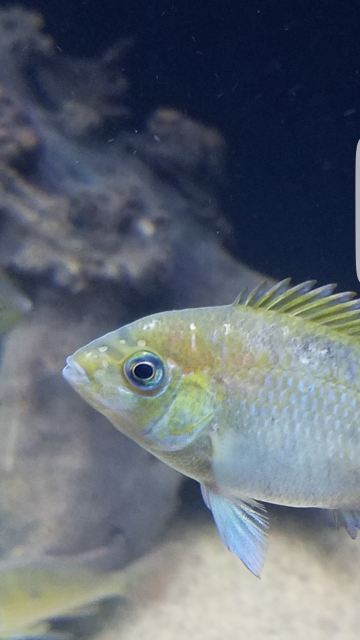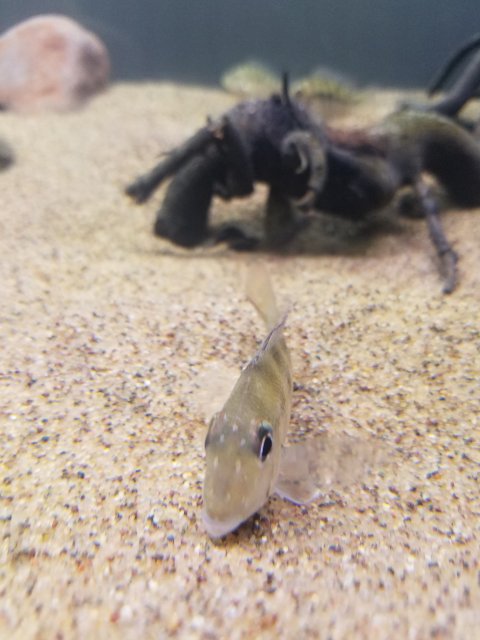Worth a read IMO. HITH - Revisted
http://www.monsterfishkeepers.com/forums/threads/hith-revisited.650466/
Good luck with your fish.
http://www.monsterfishkeepers.com/forums/threads/hith-revisited.650466/
Good luck with your fish.
Not to derail this thread but if ur fish has hith then needs to be qt'd and start meds. It's already stressed cause of possibility of infection. Post in the disease section so you can get some help. Will needs pics and water parameters, tankmates etc.am i going to have to quarantine the fish or would just adding vitachem to tank and food work ? i feel adding my parrot to a 10 gallon (my only spare tank) will probly stress it out and be worse for it
Worth a read IMO. HITH - Revisted
http://www.monsterfishkeepers.com/forums/threads/hith-revisited.650466/
Good luck with your fish.


How do you know of the pellets are high quality and what other high-quality food can I feed my fish other than pellets?Okay, let's talk about Hole in the Head.
What causes it?
- You will hear a million different theories - ready to hear mine? years of collective research and gathering opinions with an open mind has led me to these conclusions..
Simply put, 'Hole in the Head' and 'Lateral Line Erosion' are caused from a nutrient deficiency.
I don't see the word THIAMIASE come up very much - when it is a very important enzyme that anyone with PREDATORY FISH should be aware of..
1) Thiaminase
Thiaminase destroys Thiamine (Vitamin B1). Goldfish & Rosie Reds (and most cyprinidae) contain a very high level of thiaminase. Thiamine deficiency can lead to a myriad of problems including neurodegeneration, wasting and death. Tissue Distribution in many living animals is dependent on Thiamine levels. Once Thiaminase is ingested, it has very long lasting effects and does not purge itself from the body. Lack of Thiamine (Vitamin B1) is the primary reason why fish would not be able to properly produce fleshy tissue.
List of fish containing thiaminase:
http://www.austinsturtlepage.com/Articles/Thiaminase.htm
2) Hexamita
The internal form of Hexamita are flagellated protozoans found in the gastrointestinal tract of a wide variety of fishes. It is believed that malabsorption of minerals and vitamins from the intestine due to heavy concentrations the Hexamita parasite makes the fish become nutrient deficient. Important Vitamins such as Vitamin B1, Vitamin K, and Vitamin C will all be absorbed by internal parasites before the fish can properly use and distribute them. This leads to severe malnutrition.
3) Water Quality
Lack of water changes and heavy amounts of 'bioload' make the nutrient level of the water very low. Nitrifying bacteria consumes vitamins and nutrients that are within the water. Larger, Robust fish that produce large amounts of waste are going to have a larger bioload, thus more nitrifying bacteria to consume nutrients. Poorly maintained filtration systems with large amounts of detritus will also create excessive amounts of nitrifying bacteria. Lack of frequent water changes allows the nutrient levels to become quickly depleted in these scenarios.
Note: Just because your Nitrates are low and your water looks clean, does not mean your fish do not benefit from replenishing nutrients through small frequent water changes.
4) Osmosis
Lack of water changes also compromises the osmoregulation system of the fish. When a fish can not adequately perform osmosis by taking in solids around them, not only are they under constant stress from this, but they are not taking in the nutrients they need. Lack of nutrients from osmosis prohibits the body's ability to produce fleshy tissue. Many hobbyist use vitamin/mineral pyramid blocks to supplement their fish. Frequent water changes also replenish the nutrient needed to aid in osmosis.
Note: Frequent water changes cause fish to grow faster and healthier, as they need a wide array of Micro and Macro nutrient in order to supplement the osmosis system. Only in domestic aquaria do fish encounter 'osmoregulatory compromise' - in which these nutrient levels become unbalanced - thus the vital need for water changes.
Note2: "Aquarium Salt" is just a quick boost in dissolved solids in the water, which will temporarily aid in the osmosis system of most fish. However, some fish are put under osmotic pressure from these solids, making it detrimental. It also stimulates slime coat and boosts electrolytes. Although a well-known 'cure-all tonic', salt can be good and bad for different reasons, however it does not supplement the need for the proper nutrients needed in osmosis.
5) Nutrition
Poor quality foods will make your fish nutrient deprived. Using cheap brands such as Wardley that is full of fillers and byproducts, does not provide the vitamin and nutrient content that large predatory fish need to re-create their diet in the wild. Low quality foods will also create more physical waste due to fillers, thus creating more nitrifying bacteria.(see above) Most vitamins and nutrients are water soluble, but people mistakingly feed frozen and flake foods. These foods are low in nutrient content. It is better to feed pelletized food, that can be ingested like a pill, in order for the fish to absorb the maximum amount of possible vitamin content. High quality super premium foods, although expensive, are well worth their nutrient content - especially to large carnivorous predators.
So, in summary - In order to prevent hold in the head..
1) No Feeder Fish
2) No Internal Parasites
3) Perform Frequent Water Changes
4) Perform More Frequent Water Changes
5) Feed High Quality Pelletized Foods
PS. Secondary Bacterial Infections from Hole in the Head are not the cause of hole in the head nor have anything to do with the nutrition issue or deterioration of fleshy tissue.
I hope someone takes something good from this postI have been pondering these thoughts for a long time and thought I would share - Hopefully someone else has some good stuff to share.. but PLEASE do your research before you start quoting an outdated website from the early 90s
Maybe someone else has some super concrete scientific links or facts about HoleInTheHead that I am unaware of?
-Miles
Thank you, this was very helpful.Okay, let's talk about Hole in the Head.
What causes it?
- You will hear a million different theories - ready to hear mine? years of collective research and gathering opinions with an open mind has led me to these conclusions..
Simply put, 'Hole in the Head' and 'Lateral Line Erosion' are caused from a nutrient deficiency.
I don't see the word THIAMIASE come up very much - when it is a very important enzyme that anyone with PREDATORY FISH should be aware of..
1) Thiaminase
Thiaminase destroys Thiamine (Vitamin B1). Goldfish & Rosie Reds (and most cyprinidae) contain a very high level of thiaminase. Thiamine deficiency can lead to a myriad of problems including neurodegeneration, wasting and death. Tissue Distribution in many living animals is dependent on Thiamine levels. Once Thiaminase is ingested, it has very long lasting effects and does not purge itself from the body. Lack of Thiamine (Vitamin B1) is the primary reason why fish would not be able to properly produce fleshy tissue.
List of fish containing thiaminase:
http://www.austinsturtlepage.com/Articles/Thiaminase.htm
2) Hexamita
The internal form of Hexamita are flagellated protozoans found in the gastrointestinal tract of a wide variety of fishes. It is believed that malabsorption of minerals and vitamins from the intestine due to heavy concentrations the Hexamita parasite makes the fish become nutrient deficient. Important Vitamins such as Vitamin B1, Vitamin K, and Vitamin C will all be absorbed by internal parasites before the fish can properly use and distribute them. This leads to severe malnutrition.
3) Water Quality
Lack of water changes and heavy amounts of 'bioload' make the nutrient level of the water very low. Nitrifying bacteria consumes vitamins and nutrients that are within the water. Larger, Robust fish that produce large amounts of waste are going to have a larger bioload, thus more nitrifying bacteria to consume nutrients. Poorly maintained filtration systems with large amounts of detritus will also create excessive amounts of nitrifying bacteria. Lack of frequent water changes allows the nutrient levels to become quickly depleted in these scenarios.
Note: Just because your Nitrates are low and your water looks clean, does not mean your fish do not benefit from replenishing nutrients through small frequent water changes.
4) Osmosis
Lack of water changes also compromises the osmoregulation system of the fish. When a fish can not adequately perform osmosis by taking in solids around them, not only are they under constant stress from this, but they are not taking in the nutrients they need. Lack of nutrients from osmosis prohibits the body's ability to produce fleshy tissue. Many hobbyist use vitamin/mineral pyramid blocks to supplement their fish. Frequent water changes also replenish the nutrient needed to aid in osmosis.
Note: Frequent water changes cause fish to grow faster and healthier, as they need a wide array of Micro and Macro nutrient in order to supplement the osmosis system. Only in domestic aquaria do fish encounter 'osmoregulatory compromise' - in which these nutrient levels become unbalanced - thus the vital need for water changes.
Note2: "Aquarium Salt" is just a quick boost in dissolved solids in the water, which will temporarily aid in the osmosis system of most fish. However, some fish are put under osmotic pressure from these solids, making it detrimental. It also stimulates slime coat and boosts electrolytes. Although a well-known 'cure-all tonic', salt can be good and bad for different reasons, however it does not supplement the need for the proper nutrients needed in osmosis.
5) Nutrition
Poor quality foods will make your fish nutrient deprived. Using cheap brands such as Wardley that is full of fillers and byproducts, does not provide the vitamin and nutrient content that large predatory fish need to re-create their diet in the wild. Low quality foods will also create more physical waste due to fillers, thus creating more nitrifying bacteria.(see above) Most vitamins and nutrients are water soluble, but people mistakingly feed frozen and flake foods. These foods are low in nutrient content. It is better to feed pelletized food, that can be ingested like a pill, in order for the fish to absorb the maximum amount of possible vitamin content. High quality super premium foods, although expensive, are well worth their nutrient content - especially to large carnivorous predators.
So, in summary - In order to prevent hold in the head..
1) No Feeder Fish
2) No Internal Parasites
3) Perform Frequent Water Changes
4) Perform More Frequent Water Changes
5) Feed High Quality Pelletized Foods
PS. Secondary Bacterial Infections from Hole in the Head are not the cause of hole in the head nor have anything to do with the nutrition issue or deterioration of fleshy tissue.
I hope someone takes something good from this postI have been pondering these thoughts for a long time and thought I would share - Hopefully someone else has some good stuff to share.. but PLEASE do your research before you start quoting an outdated website from the early 90s
Maybe someone else has some super concrete scientific links or facts about HoleInTheHead that I am unaware of?
-Miles


